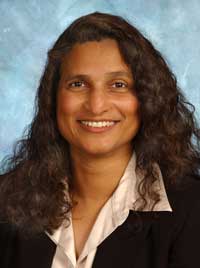 |
Sushma Rai, M.D. |
About 16 years ago, eye redness and irritation caused her to see an optometrist, who initially thought Hileman was suffering from allergies. But as the symptoms persisted, she was tested for glaucoma.
The test results came back and at age 39, with no family history of the ailment, Hileman was diagnosed with glaucoma. The late diagnosis allowed for significant damage and substantially reduced vision to occur in her left eye.
“I hadn’t realized my peripheral vision in my left eye was lost because my right eye compensated,” Hileman said. “I constantly have to be aware of my surroundings or I might not see something and fall. It’s something I have to constantly think about.”
Now 55, she has had a number of surgeries on both eyes, was placed on three kinds of eye drops and regularly sees an ophthalmologist.
Today (March 6) is the first World Glaucoma Day, which Sushma Rai, M.D., UNMC assistant professor of ophthalmology, said serves as reminder that people should consider getting screened early to avoid problems such as those experienced by Hileman.
Glaucoma is a group of diseases that commonly cause damage to the optic nerve and create abnormally high pressure inside the eyeball.
It is the second-leading cause of blindness in the United States behind age-related macular degeneration. Glaucoma can be slowed but most who have the condition do not know they have it because symptoms only show late in the disease progress, when a significant part of the vision been irretrievably lost.
It’s predicted that by the year 2020, 80 million people worldwide will have glaucoma, and 11 million of them will be blind in both eyes.
“This is all about getting the word to the people to get an eye exam,” Dr. Rai said. “It is really frustrating to me to see patients with advanced glaucoma knowing if they would have come to me sooner, we could have slowed down the progression.
“There’s less chance of going blind if you’re diagnosed early so you can get on medication (eye drops), or have laser procedure or surgery, which reduces eye pressure.”
She said vision loss associated from glaucoma doesn’t necessarily mean losing all vision.
“It affects peripheral vision so you can have difficulty driving, difficulty walking and end up bumping into things,” Dr. Rai said. “It also is associated with depression because it affects quality of life. It’s not just a physical limitation.”
|
Physicians will go to Capitol Hill to talk to Congressmen and provide glaucoma screenings.
World Glaucoma Day is a joint initiative of the World Glaucoma Association and the World Glaucoma Patient Association. The WGA will announce two initiatives:
- “No more than Twenty by Twenty-Twenty,” which is a program aimed at increasing the diagnoses of glaucoma; and
- A “Glaucoma Patient’s Bill of Rights,” which is aimed at educating glaucoma patients about the disease and treatment options.
The message of both initiatives is that the effects of glaucoma on sight are irreversible, so the earlier the condition is treated, the more sight can be preserved. Treatment is usually effective in preventing further damage.
As a result of the increasing population and increasing numbers of the aging population, glaucoma is increasing worldwide, resulting in an increase of people going blind.
In developed countries such as the United States and Canada, 50 percent of glaucoma patients are not diagnosed. Earlier diagnosis and treatment will reduce visual disability caused by glaucoma, improving individuals’ quality of life and decreasing costs of treatment.
|
|
In addition, those on certain medications that can cause high eye pressure, such as steroids, or who have suffered eye injuries should get screened.
Hileman is an advocate of early screenings.
“It would have saved some of the vision in my left eye,” she said. “Now I make sure my daughters get in every year.”
To make an appointment for a glaucoma screening with UNMC Physicians, call 559-2020. Health insurance may pay for some screenings. Check with your health insurance provider. For more information on glaucoma, visit www.wgday.net.